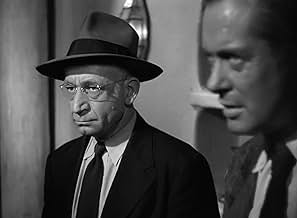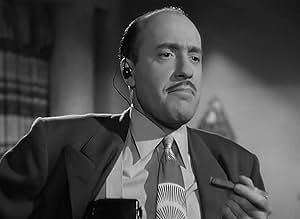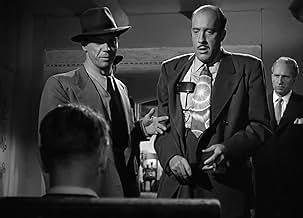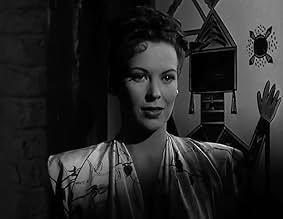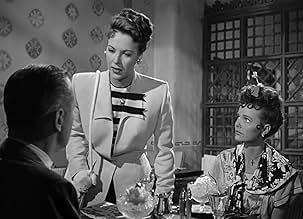IMDb-BEWERTUNG
7,2/10
3666
IHRE BEWERTUNG
Füge eine Handlung in deiner Sprache hinzuWW2 veteran Lucky Gagin arrives in a New Mexico border-town intent on revenging against mobster Frank Hugo but FBI agent Bill Retz, who also wants Hugo, tries to keep Gagin out of trouble.WW2 veteran Lucky Gagin arrives in a New Mexico border-town intent on revenging against mobster Frank Hugo but FBI agent Bill Retz, who also wants Hugo, tries to keep Gagin out of trouble.WW2 veteran Lucky Gagin arrives in a New Mexico border-town intent on revenging against mobster Frank Hugo but FBI agent Bill Retz, who also wants Hugo, tries to keep Gagin out of trouble.
- Für 1 Oscar nominiert
- 1 Gewinn & 1 Nominierung insgesamt
Jose Alvarado
- Mexican Boy
- (Nicht genannt)
Jimmy Ames
- Thug
- (Nicht genannt)
Connie Asins
- Vocalist
- (Nicht genannt)
Empfohlene Bewertungen
Not quite sure what to make of this one, but definitely interesting. One is never certain if its strangeness is due to inexperience on the part of the film-makers, or if it truly is an unambiguous artistic choice. The director and star, Robert Montgomery, was very much a creature of 1930's pre-war Hollywood and the film seems to be an unconscious attempt to transplant pre-war film-making sensibilities into the decidedly post-war genre of Film-Noir, with all of its fatalism, disillusionment and complications. It's as if Montgomery is an alien from the 30's exploring a strange, post-war Noir world; rejoicing and experimenting in this permissive new environment, but ever aware that he is not a native. (Though it's highly unlikely this idea ever occurred to him in such a concrete way, as this genre was not identified as such until French critics of the 1960's uncovered a new pattern in American films dealing with crime.)
There's much here that I, quite frankly, didn't understand. You never really get a handle on any of the characters or what their true motivations are; they're all tantalizingly enigmatic, opaque, but that is admittedly much of the joy of the picture. Everyone seems to be suffering from some kind of guilt that they just don't seem quite able to articulate, much less expiate, so they keep muddling along hoping that they'll stumble across an answer or justification for their sins. The villain of the piece, Fred Clark, is odd. He doesn't just want to trick Montgomery out of the money he's blackmailing him for, he wants to shame him for not being smart and demanding more. Montgomery is mighty odd as well, with some kind of a stubborn, indecipherable personal code of honor; sort of a dumbed down Sam Spade. He's trying to carve out some little island of corruption just for himself, stiff-arming both sides of the law in the process. Most peculiar is the little peasant girl played by Wanda Hendrix. She is instantly devoted to Montgomery, lovingly helps him out of a couple jams but at the end after they say goodbye, she makes some little speech to her friends in Spanish (w.o. subtitles) that gives the impression she was never as innocent as she let on. But what did she gain? And Art Smith (a good crafty little character actor who keeps turning up and making an impression in a lot of films I've been seeing like "Brute Force", "The Next Voice You Hear" and "In A Lonely Place") is an FBI agent who is more like Montgomery's guardian angel. He is almost God-like in how he can pinpoint the exact motivation behind Montgomery's every move and thought.
All these actors are fine, but Thomas Gomez steals every scene he's in as the deceptively heroic operator of the merry-go-round. He is involved in the film's most brutal and poignant scene, as he is beat up by a couple of Clark's thugs (as the children watch captively on the spinning carousel) for refusing to reveal his friend Montgomery's whereabouts. And I love his great line when Montgomery stumbles back for help after getting stabbed in a fight. He shrugs wearily and says "when you're young everyone sticks knife in you."
I couldn't for the life of me figure out why the movie would be called "Ride the Pink Horse", but I like the other reviewer's theory that it has to do with the arbitrary nature of life itself. A definite cult item.
There's much here that I, quite frankly, didn't understand. You never really get a handle on any of the characters or what their true motivations are; they're all tantalizingly enigmatic, opaque, but that is admittedly much of the joy of the picture. Everyone seems to be suffering from some kind of guilt that they just don't seem quite able to articulate, much less expiate, so they keep muddling along hoping that they'll stumble across an answer or justification for their sins. The villain of the piece, Fred Clark, is odd. He doesn't just want to trick Montgomery out of the money he's blackmailing him for, he wants to shame him for not being smart and demanding more. Montgomery is mighty odd as well, with some kind of a stubborn, indecipherable personal code of honor; sort of a dumbed down Sam Spade. He's trying to carve out some little island of corruption just for himself, stiff-arming both sides of the law in the process. Most peculiar is the little peasant girl played by Wanda Hendrix. She is instantly devoted to Montgomery, lovingly helps him out of a couple jams but at the end after they say goodbye, she makes some little speech to her friends in Spanish (w.o. subtitles) that gives the impression she was never as innocent as she let on. But what did she gain? And Art Smith (a good crafty little character actor who keeps turning up and making an impression in a lot of films I've been seeing like "Brute Force", "The Next Voice You Hear" and "In A Lonely Place") is an FBI agent who is more like Montgomery's guardian angel. He is almost God-like in how he can pinpoint the exact motivation behind Montgomery's every move and thought.
All these actors are fine, but Thomas Gomez steals every scene he's in as the deceptively heroic operator of the merry-go-round. He is involved in the film's most brutal and poignant scene, as he is beat up by a couple of Clark's thugs (as the children watch captively on the spinning carousel) for refusing to reveal his friend Montgomery's whereabouts. And I love his great line when Montgomery stumbles back for help after getting stabbed in a fight. He shrugs wearily and says "when you're young everyone sticks knife in you."
I couldn't for the life of me figure out why the movie would be called "Ride the Pink Horse", but I like the other reviewer's theory that it has to do with the arbitrary nature of life itself. A definite cult item.
I don't really care very much for Robert Montgomery as a serious actor; they must have been at least a half dozen or more Hollywood actors at the time who could have handled the role better: Bogart, Cagney, Flynn, Power, Holden, Ford (etc). But despite being miscast, Montgomery pulls it off with some help from a great supporting cast. Great writing by a woman writer, Dorothy B Hughes, and a great screenplay by Lederer and Hecht (Lancaster's old buddy) provides the viewer with a real treat for atmosphere and storytelling. Gagin comes to New Mexico to square accounts with the guy who shot his partner, Shorty. Mr. Hugo is well-played by. Fred Clark. But the person who steals this film is not Montgomery, Clark or even Thomas Gomez, who was nominated for a Best Supporting Actor role as Pancho in the film. No, the film is stolen by actress, Wanda Hendrix as Pila, a wild-looking, space cadet, who is fiercely loyal to Gagin. One of the best film noir pieces you will ever see.
From the film's opening scene, which shows the protagonist, Lucky Gagin, emerging from a bus into a dusty Mexican town, the viewer is hooked. There are so many good things about this film, primarily the acting performances -- Robert Montgomery is a standout, as are Wanda Hendrix, Fred Clark, Thomas Gomez, and Art Smith. They each completely occupy their characters and make them come to life. Another highlight is the dialogue -- there are numerous memorable exchanges between Montgomery and Hendrix, and Clark delivers two especially well-written diatribes that serve to solidify his character in the consciousness. The story itself is quite simple, and is driven far more by characterization than by plot, but that is what makes the film so good. The film also contains its share of classically dark noir imagery -- most memorable is the scene in which the Gomez character is savagely beaten by two hoods while a group of neighborhood children sail along on the nearby merry-go-round, at first gaily enjoying the free ride but growing increasingly somber and afraid as they witness the brutal attack. This one is a definite must-see, particularly for film noir buffs, but also for film lovers of all types.
In one of a couple of films done at Universal starring Montgomery that are hard to find. Ex-solider Lucky Gagin (Robert Montgomery) arrives in the little southwestern town of San Pablo during a hectic fiesta weekend. He's come here seeking revenge against the man he holds responsible for his friend's death. But his quest may be derailed by one of the motley assortment of characters he meets: scheming federal agent Retz (Art Smith, spooky-eyed young Mexican girl Pilar (Wanda Hendrix), and boisterous carousel operator Pancho (Thomas Gomez), among others.
Montgomery does a very good job in both the directing and acting departments. The film showcases several stylish flourishes, and maintains an evocative, "stranger in a strange land" aura of uncertainty and mild paranoia. His performance as the plainspoken Gagin is also a nice stretch from his usual smooth charmer. He's blunt, occasionally rude, maybe not the sharpest guy in the room, but cunning enough to be a threat to those he targets.
The movie takes an unexpected turn in the last third which helps set it apart from the other crime pictures of the period, but in my opinion it weakened the resolution a bit. I liked Hendrix, and Gomez is affable in a character type he would go on to play several times in the future. Fred Clark, as a crime boss, and Art Smith as the fed, are unusual casting choices that work. The movie earned an Oscar nomination for Best Supporting Actor for Thomas Gomez.
Montgomery does a very good job in both the directing and acting departments. The film showcases several stylish flourishes, and maintains an evocative, "stranger in a strange land" aura of uncertainty and mild paranoia. His performance as the plainspoken Gagin is also a nice stretch from his usual smooth charmer. He's blunt, occasionally rude, maybe not the sharpest guy in the room, but cunning enough to be a threat to those he targets.
The movie takes an unexpected turn in the last third which helps set it apart from the other crime pictures of the period, but in my opinion it weakened the resolution a bit. I liked Hendrix, and Gomez is affable in a character type he would go on to play several times in the future. Fred Clark, as a crime boss, and Art Smith as the fed, are unusual casting choices that work. The movie earned an Oscar nomination for Best Supporting Actor for Thomas Gomez.
This is a classic pseudo film noir. It means to emulate, but not necessarily be, a true film noir.
Robert Montgomery is excellent and believable as a man driven to revenge the death of his war time pal.
The scenes with Wanda Hendrix as, in turns, a guileless teen, a knowing friend and a woman who 'sees things' are taut and dramatic. There are a few moments of humor there too.
Mr Montgomery's direction is both intelligent and convincing. There are moments of drama. Moments of near pathos. Moments of comedy. Moments of boredom - from the characters, not the audience.
The 'Fed' and 'Pancho' the carousel owner are interesting and engaging characters. Not hollow or cardboard cutouts that one might see in some films.
All in all it is a very enjoyable film and a must see for those that appreciate both the acting skills and the directorial skills of Mr. Robert Montgomery.
Robert Montgomery is excellent and believable as a man driven to revenge the death of his war time pal.
The scenes with Wanda Hendrix as, in turns, a guileless teen, a knowing friend and a woman who 'sees things' are taut and dramatic. There are a few moments of humor there too.
Mr Montgomery's direction is both intelligent and convincing. There are moments of drama. Moments of near pathos. Moments of comedy. Moments of boredom - from the characters, not the audience.
The 'Fed' and 'Pancho' the carousel owner are interesting and engaging characters. Not hollow or cardboard cutouts that one might see in some films.
All in all it is a very enjoyable film and a must see for those that appreciate both the acting skills and the directorial skills of Mr. Robert Montgomery.
Wusstest du schon
- WissenswertesFilmed in Santa Fe, the burning of Zozobra, which began in 1924, is still an annual festival occurring in September.
- PatzerOpening scene at the bus station, Montgomery walks over to the gum machine to insert his coin, but the gum package is already present before he inserts it.
- Crazy CreditsThe main title card reads, "as LUCKY GAGIN in RIDE THE PINK HORSE." The film's title is in far smaller type than the character name.
- VerbindungenFeatured in Pulp Cinema (2001)
Top-Auswahl
Melde dich zum Bewerten an und greife auf die Watchlist für personalisierte Empfehlungen zu.
- How long is Ride the Pink Horse?Powered by Alexa
Details
- Erscheinungsdatum
- Herkunftsland
- Sprachen
- Auch bekannt als
- Ride the Pink Horse
- Drehorte
- Produktionsfirma
- Weitere beteiligte Unternehmen bei IMDbPro anzeigen
Box Office
- Bruttoertrag in den USA und Kanada
- 2.000.000 $
- Laufzeit
- 1 Std. 41 Min.(101 min)
- Farbe
- Seitenverhältnis
- 1.37 : 1
Zu dieser Seite beitragen
Bearbeitung vorschlagen oder fehlenden Inhalt hinzufügen

